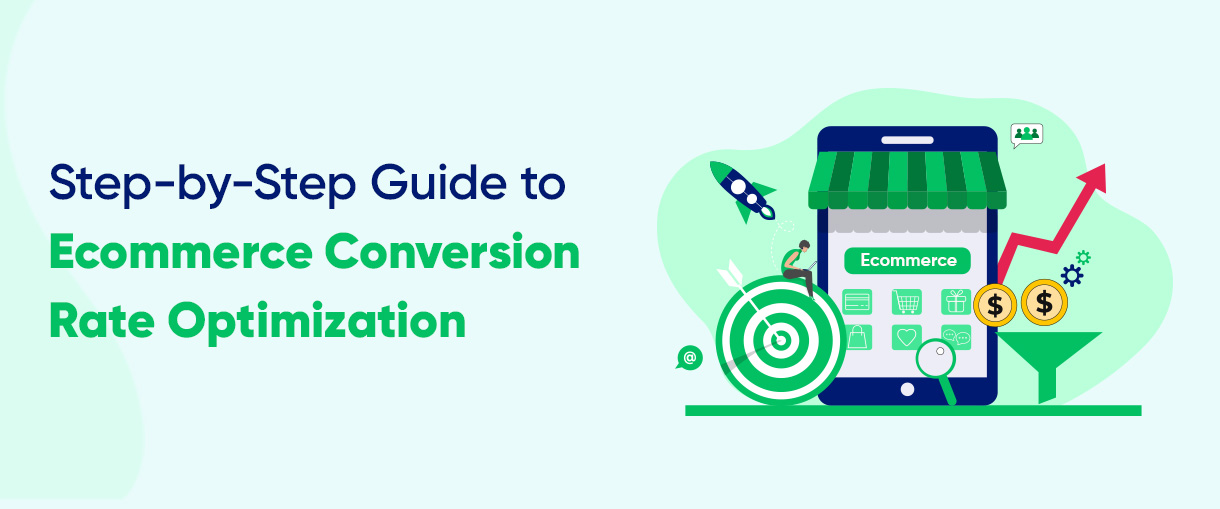Many business owners and marketers spend millions working on increasing web traffic. And while website traffic attracts attention, it doesn’t necessarily convert visitors into paying customers. Conversions are crucial whether you are starting a new business or trying to develop an existing one. There are many tips on running ecommerce conversion rate optimization campaigns, but not much information about the process. How to begin? How to proceed? What does it take to run a successful CRO campaign?
There’s no point in randomly tweaking your website without following the appropriate process. So, today, we will talk about the step-by-step process of running a CRO campaign. We have divided the entire ecommerce conversion rate optimization process into five steps. But before we dive into the detailed 5-step process, let’s quickly read about what is ecommerce Conversion Rate Optimization and the factors that affect conversions.
What is CRO?
CRO stands for Conversion Rate Optimization. It is the process to enhance your website to increase the number of visitors who become customers. You can achieve CRO through tweaking content, A/B testing, and workflow improvements. Various factors affect conversions, including:
- Website UX
- Page design, layout, text, images, font, color
- Customer’s purchase intentions
- No. of on-site reviews
5-Step Process Of Ecommerce Conversion Rate Optimization
Learning conversion optimization is crucial, especially if you run an online business. Here are five easy steps to ace your CRO campaign.
1. Research and Data Gathering
The first step is gathering pertinent data (qualitative and quantitative) to perform conversion analysis. Though it is a time-consuming step, it’s worth doing it to save yourself a lot of time down the lane. Collecting relevant information is of utmost importance as it helps you understand your visitors. Rather than optimizing purely out of gut instincts, making data-backed decisions is always a better idea.
You can gather quantitative data using click-through rate (CTR), bounce rate, traffic sources, demography, heatmaps, surveys, session replays, and many more.
Qualitative data answers why your visitors/customers behave a certain way. You can conduct polls, run on-site surveys & satisfaction surveys, take user interviews, and engage in focus groups, to collect qualitative data.
2. Hypotheses
Based on the information you have gathered during the first step, you can now form a hypothesis for further work. The idea for ecommerce conversion rate optimization is a tentative assumption (based on statistical evidence) for trying out ways to achieve your goals. Next, you must run A/B tests to see what works for you and what doesn’t. It appears to be a simple task, but only if done correctly!
3. Prioritization
You will likely have a long list of hypotheses you want to test. How do you decide the precedence? Prioritizing hypotheses is brilliant as it helps solve the most pressing business issues. Plenty of tools help you prioritize and focus on essential things. One such tool is the PIE Framework, which considers three factors – Potential, Importance, and Ease.
Potential: how much improvement can be made
Importance: how valuable is the page or experience
Ease: how easy it is to test
Though it is a perpetual process, it will help you make powerful improvements to your website/landing pages/email funnel/sales funnel, helping you take your business to the next level.
4. Testing
Now that you have prioritized the hypotheses, you will know which tests to implement. Testing is something that you should do consistently to gather insights and learn. When executed correctly, testing yields powerful results.
5. Learning
The final step is learning what is appropriate and essential for your business growth. Next, analyze the testing results and the growth potential for your business. Then, keep optimizing your strategies, content, and design to hit your goal.
Read more: A Complete Guide To Shopify Conversion Rate Optimization
Conclusion
Suppose you want to see your conversion rate grow significantly. In that case, you have to learn how to do the proper A/B tests, and you need a better understanding of the entire conversion optimization process. Following the guide above will improve your ecommerce conversion rate optimization strategy, and you can hope for the desired results.
For more queries, you can contact us. We are always at your disposal. Right, let’s get into the process!

